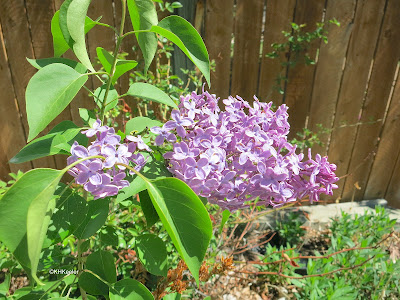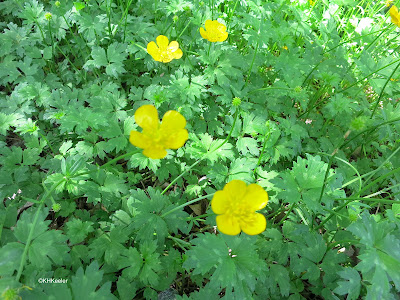I've always liked native plants--stately cottonwoods (Populus deltoides), dramatic redbuds (Cercis canadensis), robin-attracting serviceberry (Amelanchier alnifolia), blanketflowers (Gaillardia species), columbines (Aquilegia species)...I can go on and on. I grow them in my yard (well, not the cottonwood, too big) because I like them. But I also have a bit of Kentucky bluegrass lawn (Poa pretense, from Eurasia), creeping buttercup as a ground cover (Ranunculus repens, from Europe), a maple (Acer, not local to area), lilacs (Syringa vulgaris, from Eurasia), iris (Iris, from all over the world), peonies (Paeonia from China), crocus (Crocus from Eurasia) and many others. I like them too.
 |
| blanket flower, Gaillardia, native |
 |
| lilacs, Syringa vulgaris, nonnative |
 |
| columbine, Aquilegia coerula, native |
The food chain begins with plants. Insects eat some part of the plant. Birds, frogs, and other small vertebrates eat the insects. Bigger predators like hawks and foxes eat those. If the insects can't eat the plants, not only do they die, but every animal up the food chain goes hungry.
Recent study (see references below) documented that bird numbers in North America have dropped 30% (almost 3 billion birds!) since 1970. A big part of that is development: roads, houses, shopping malls, and parking lots that have few or no plants to produce insects compared to the forest or grassland that was there before. We think our environment is green because we put plants around our houses, but the bluegrass lawn is an exotic insect-poor monoculture and the peonies, lilacs, and creeping buttercup are exotics native insects can't eat. Biologists working on this problem have documented that few native insects eat non-native plants because plants defend themselves with unique poisons, so animals have to specialize to detoxify the poisons, which ends up with them eating just one or a few plants. Alas, they can rarely overcome the defenses of alien plants. And, if insects aren't eating, and creating more insects, there is no food for birds. We are seeing the consequences.
 |
| peonies, Paeonia species, nonnative |
The solution, coming from Douglas Tallamy and others, is Homegrown National Park (link). That is, we don't leave it to someone else to provide the plants at the bottom of North American food chains, but we all pitch in. If each of us grows a few natives in our yards, it adds up to a massive resource for native animals. For the most part our birds aren't extinct and will rebound in numbers if conditions improve.
 |
| creeping holly grape, Berberis repens, native |
That's a compelling reason to grow native plants, particularly plants native to your immediate area, not just North America. I am convinced by the logic (see Tallamy's writings in the references for more detail). But...my yard is easily 80% nonnatives. I could swap out a LOT of plants to be more of a supporter of Homegrown National Park. And, as always the devil is in the details. I'm thinking hard about how to shift to a yard that has more natives than exotics (a humble goal, really) and will write about some of the issues in the future.
 |
| creeping buttercup, Ranunculus repens, nonnative a pest east of us, but a nice ground cover in Colorado |
Comments and corrections welcome.
References
Axelson, S. 2019. Vanishing: More Than 1 in 4 Birds Has Disappeard in the Last 50 Years. Living Bird. Autumn 2019. link Accessed 3/25/22.
Cornell Laboratory of Ornithology. Nearly 3 Billion Birds Gone. link Accessed 3/25/22. Includes link to pdf of the Science paper that reported this. (also listed below on Science's website).
LearnBirdWatching.org Do Birds Eat Caterpillars? The Answer Might Surprise You. link (Accessed 3/25/22).
Renault, M. 2020. An Ode to Nature's Hotdogs: Moth Caterpillars. Audubon. link
Rosenberg, K. V., A. M. Dokter, P. J. Blancher, J. R. Sauer, A. C. Smith, P. A. Smith, J. C. Stanton, A. Panjabi, L. Helft, M. Parr, P. P. Marra. 2019. Decline of North American Avifauna. Science 366: 120-124. link
Tallamy, D. W. 2017. Bringing Nature Home. Timber Press. Portland, Oregon.
Tallamy, D. W. 2020. Nature's Best Hope. Timber Press. Portland, Oregon.
Tallamy, D. W. webpage: link
Tallamy, speaking to the meeting Landscaping with Natives in Northern Colorado on 2/28/22 had impressive graphs of the % of the diet of nestlings that were caterpillars (70% for bird species after bird species). I cannot find a reference, so that may not have been published yet, but only gathered from the scattered literature. The Learn Bird Watching article has a list of common birds that eat caterpillars (though without references) and a lot about why.
Kathy Keeler, A Wandering Botanist
More at awanderingbotanist.com
Join me on Facebook: https://www.facebook.com/AWanderingBotanist
I am doing a "happy dance". You are a powerful and articulate voice. <3
ReplyDeleteOh...one thing I did, is to find places poorly utilized...native ferns LOVE under the porch where they volunteered. My ditches, based on a bio-blitz done with the Nature Conservancy turned out to be incredibly bio-diverse, and they are more-so now 15 years later of removing invasive species and seeding native ones. So look around...and do the change gradually...if you have a diverse array of plants, you want to do this slowly anyway, so that the generalists that are there now don't lose habitat. This is not a "guilt-laden" activity, but hope for the future...each plant planted is a step in the right direction. Document what you have now...and watch it with delight over time. We had 5 species of invertebrates in a lawn that we converted to native grasses and forbs...and in 3 years had 135 species, plus migrating birds stopping in that we had not seen before. Hurrah and have fun!
ReplyDeleteImportant to protect green spaces
ReplyDelete